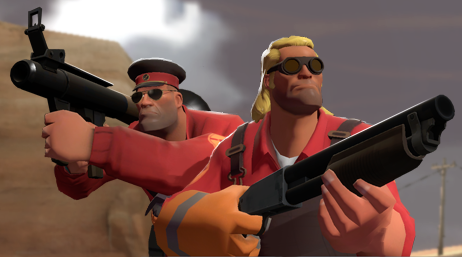 It looks more organic than robotic.
It looks more organic than robotic.
The four legs march under the barrel chest of the robot, snapping up two at a time in perfect precision. But when Boston Dynamic's creation, BigDog, is pushed, or it walks across ice, it suddenly looks very much alive as it stumbles to correct itself, and succeeds.
 Designed to be the robotic replacement for pack animals or small vehicles, this future day robotic mule almost resembles the product of video games like Metal Gear Solid, Half-Life 2 or Portal.
Designed to be the robotic replacement for pack animals or small vehicles, this future day robotic mule almost resembles the product of video games like Metal Gear Solid, Half-Life 2 or Portal.
Video of the quadruped robot first hit in 2008 and last month the company behind the design got an order for a super fast version and a human-like two-legged robot leading readers to liken their look to works of fantasy and fiction.
But robotics design company Boston Dynamics says the design similarities are purely coincidental. Their U.S. military funded robots are products of pure functionality, aesthetics doesn't enter into their creations.
"We did not do any aesthetic design on BigDog," said Marc Raibert, former MIT professor and founder of Boston Dynamics. "We talk about getting a designer to work on (the military version of BigDog), but have not done anything about it. We sometimes use artists to create concept sketches when developing new ideas for robots, but the robot designers do not use the sketches when doing the designs."
When people see his company's robots in action and think Transformers or robots from video games it's because of their own imagination, not his company's designs.
"I think much of what a person sees when viewing a robot comes from what is already in the person's head," he said. "Like a Robot Rorshach test."
 Raibert says that the company has been in touch with some high-end car designers about the Legged Squad Support System, the follow up to BigDog destined for military use, but that they haven't hired anyone yet.
Raibert says that the company has been in touch with some high-end car designers about the Legged Squad Support System, the follow up to BigDog destined for military use, but that they haven't hired anyone yet.
"We are working on LS3, which is the follow-on to BigDog and closer to fielding," he said. "It might get skins to help keep the dirt and water out. Right now we are focused on functionality. We might make a cosmetic pass later, but there are quite a few constraints just based on functionality, such as packing everything in and retaining mobility."
I asked Raibert if his company plans, during the final stages of design, to change the look of the robots meant for military use. Would he want to design them to instill a sense of fear in those that see them, or perhaps to help an operator form some sort of bond with the bots.
No, Raibert says, instead the company's focus is on "mobility, reliability, ease of use, range, load carriage, etc."
Raibert says his designers aren't even that worried about the uncanny valley. The notion of the uncanny valley first came up in robot design and later became a concern in video game graphics. The theory is that the more robots look and act like humans, the more revulsion real humans will feel toward them.
While Boston Dynamics is working on two robots that will take on the form of humans, PETMAN and the military-funded Atlas, the designers don't seem too worried about that valley.
"We sometimes talk about uncanny valley with respect to them, though the focus in our discussions is on their behavior and the quality of their motion, rather than on the exact robot shape and coverings," Raibert said.
And what of those first soldier destined to work alongside these bulking, four-legged and two-legged robots? Is it possible that a robot design could fail simply because the people who will work with them must are repulsed by them?
Raibert says his company hasn't done any studies to look into the possible effects of the uncanny valley on soldiers in the field, but he thinks Atlas, Cheetah and LS3's usefulness will outweigh any aesthetic issues.
"I think if the robots we built help soldiers and marines carry heavy stuff, so they don't have to carry it themselves, they will think LS3 or BigDog is a beautiful thing, no matter what it looks like," Raibert said. "Same for any other function that helps them with their jobs. For all I know, they may like it better if it is ugly, like the family mutt."
Well Played is an internationally syndicated weekly news and opinion column about the big stories of the week in the gaming industry and its bigger impact on things to come. Feel free to join in the discussion.









 Designed to be the robotic replacement for pack animals or small vehicles, this future day robotic mule almost resembles the product of video games like
Designed to be the robotic replacement for pack animals or small vehicles, this future day robotic mule almost resembles the product of video games like  Raibert says that the company has been in touch with some high-end car designers about the Legged Squad Support System, the follow up to BigDog destined for military use, but that they haven't hired anyone yet.
Raibert says that the company has been in touch with some high-end car designers about the Legged Squad Support System, the follow up to BigDog destined for military use, but that they haven't hired anyone yet.